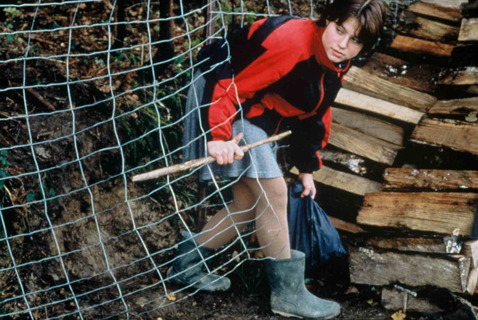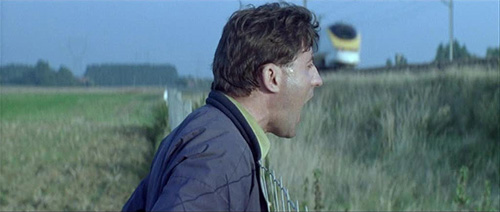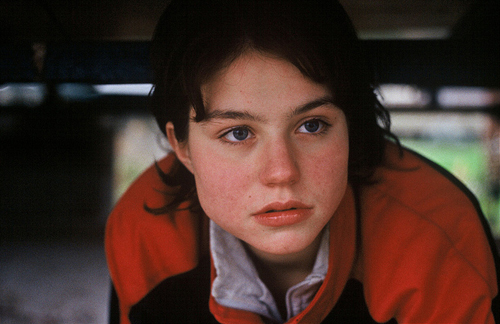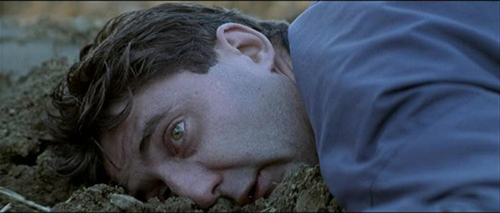
About Rosetta and L’Humanité
By Jacques Rancière
Originally published as ‘Le bruit du peuple, l’image de l’art. A propos de Rosetta et de L’Humanité’, Cahiers de Cinema, No. 540 (November 1999)
What is it that Rosetta and L’Humanité have in common, besides the fact that they were both presented at the Cannes festival, where they were as acclaimed by the jury as they were dismissed by a large part of the professionals and critics? What makes them both symbol or symptom, although Bruno Dumont’s wide shots, distanced view and esthetico-spiritualist discourse seems to be completely opposite to the panting camera, the lens glued to the characters and the denunciatory tradition characterizing Rosetta? That Bruno Dumont continues to film the lower class people of the North and the brothers Dardenne the slums and wastelands of Wallonie, that this same North and these same people have also featured in La Vie Rêvée des Anges: for some this seems to be enough reason to proclaim – and generally deplore – a new wave of “realism” and a new compliance of art with the “social”. These judgements themselves can be understood on two levels. In one sense, they offer support to the dominant ideas of a time and an intelligentsia who think that, when it comes to the people, we have definitely given enough or even too much. In another sense, they adjoin a problematic esthetic belief that bestows on art the properties of the featured subjects. The poor, the North: of course this goes back to Zola (specifically Germinal) – this is realistic art, social or “committed” art, and all of this has had its time.
The problem, of course, is knowing if Zola’s art is more realistic and more “social” when he describes the heat of the mines than when he describes the heat of the greenhouse of hotel Saccard at Parc Monceau*. Apparently more than one critic seems to think wholeheartedly that a film is a pure form of art when it develops a Marivaux-like intrigue situated around the Passy subway station* and that it commits itself to the social when its characters live in a suburb and are poorly housed or unemployed. As a matter of fact, this way of thinking still belongs to the era when Monsieur de Pontmartin opposed the villagers’ platitudes of Madama Bovary with an analysis of fine and complex sentiments of this “exquisite world” from the times of Princcess de Clèves who “only beheld the lower class people through the door opening of her stage coaches and the countryside only through the window of her palaces”*. And we could be tempted to remind those critics what Flaubert meant to demonstrate: that modernity, when it comes to art, resides precisely in this: in regards to the absolute of style, there are no more beautiful or ugly subjects, Yvetot is as good as Constantinopel*, a farmer’s daughter is as good as a society woman. We could conclude that, as for cinema, true heir of the 19th century novel, the issue was settled before its birth and that the art of Bruno Dumont or the brothers Dardenne is no more or less social that the one of Eric Rohmer or Raoul Ruiz, just as A la recherche du temps perdu is no more or less than the one of Madame Bovary.

This response would however fall a bit short. What Madam Bovary showed us, was not simply that all subjects were worthy and that only the style of the artist could make the difference. It was the paradoxical identity between the “realist“ insignificance of the subject and the autonomous splendor of “art for art’s sake”. The representative art of former days demanded to choose “noble” subjects and to adapt the adequate genres and forms accordingly. The new antirepresentative art imposed another form of identity between form and content. From then on, the supreme mark of art was to reach the point of identity between the determined and the undetermined, of sense and non-sense, human and inhuman, where the style of the artist identified itself with the subject’s way of being. Flaubert called this point stupidity. “Masterworks are stupid” he said and his contemporaries, reading his novels, felt that something exceeded their understanding in this implacable power which did not work in spite of but because of the nullity of the action and the stupidity of the characters, because of the excess of their brutal and stubborn presence, in defiance of all codification of social species, fictional types and narrative plausibilities.
Today the lesson is at once well assimilated and subject to caution. On one hand, we could say that the Rosetta effect or the Humanité effect are strict applications of the Bovary effect. Rosetta is not a representative of the sous-proletariat whose misery, defined by the close-ups of the camera, moves us and makes us aware of the condition of her peers. The close-ups of faces in Rosetta and l’Humanité don’t bring us closer to the human face and suffering. On the contrary, they exert the function that is superbly described by jean Epstein and covered by Gilles Deleuze: to transform a part of the human body in strange reliëf or monstrous animal. Rosetta’s stubborn obstinacy, her punches or her belly contracted by pain, just like the tired redness of Domino’s enjoying face or the sweat on the policeman’s bloated face are not the revealing properties of a social state to be experienced in all its cruelty. They are properly the subject of art, the brutal presence, the “stupidity” in which the will of art realizes itself as art while canceling itself as will. In this, despite appearances, they pertain more to the esthetic tradition than the elegant variations used by Rohmer to adjust the scenarios and the codes of classical sentimental intrigues to the observation of new social types and behaviors.

But the formula has also lost its innocence. On one hand, it works too well for it not being manipulated to excess. On the other, we question its bare efficiency and we look for supplements. One on hand, we add to the rawness. And this is the point where the Dardenne’s punchy camera meets with Bruno Dumont’s entomological camera. The first adds to Rosetta’s obstinacy while rattling our view, which is condemned to follow the swirl of the mobile camera running behind her, gluing us body-to-body to the alcoholic mother, opening our ears to the gasping of her efforts to survive, the punches she gives at every object within reach and the obsessive fear of motor noises besieging her. The second adds to the anguish of Pharaoh while aiming the lens at a hand starting up, on the car radio, harpsichord music with a paroxystic sound, or at the brutality of Joseph and Domino’s coupling, planting the camera at a distance and a height that inflame the ugliness of the postures and the pure mechanics of the masculine effort, and while putting in our ears, along with Domino’s wild screams of pleasure, the hyper-realistic hammer sounds of Joseph’s punches. This is how the Bovary effect finds itself transferred to a point of excess where it turns over to its opposite, where the “effect of art”, coupled with the demonstration of the world’s absurdity, reintroduces a caricature social typecasting. The Dardenne’s projecting camera and Dumont’s distancing camera make us pass the wall of the image in order to enclose us in a sonorous universe, a rumbling of origins where it is imposed that, like the sweat of the proletarians is a property of their skin, their breathing is noisier and their sex action louder than that of the bourgeoisy.
But this excess is also a duplicity. Both films apply the original formula of esthetic “modernity”. But none of them want to limit themselves to its powers. In Rosetta the identification between the obstinacy of the fictional character and the panic of the image and sound plays with the boundaries between two poetics and two politics: on one hand, the racing camera conforms itself to the pure vital energy of the wild child, to the pure non-sense of a universe of sound and furor, situated beyond all social representativeness. But Rosetta’s obstinacy is not only that of the little wild child fighting for her survival. It is an illustration of a classical topos of proletarian dignity: Rosetta wants to have a “real” job and place in society, even if it means using all kinds of cunning to assure herself this place to the detriment of others. The pure scrolling of chases and punches of the wild child is also a Brechtian fable: Rosetta is a “courageous child”, attesting to the dehumanization a society inflicts on people. And the perpetual camera movement gluing us to her body enhances the classical gesture of the militant or the sociologist and obliges us to share the sensorial experience of the inhabitant of this world, so close that we would rather not see it. Rosetta accumulates the power of the art of what doesn’t wanna say anything and the overwhelming force of the testimony that doesn’t need words.

Dumont’s strategy is more insidious. He places himself resolutely beyond the era of social struggles and militant denunciations. And he affirms that he makes art and only art. But this affirmation passes through a double road. On one hand it makes use of the classical forms of quotation and auto-demonstration. The body of the girl, turned towards the same posture as the mannequin in (Duchamp’s) Etant donné… seen through the door opening of the Museum of Philadelphia, warns us, with its celluloid texture, the make-up red of her blood and the very pictorial ant, that “this is art”. The visit to the museum, the perspective of the road and the church, the look on the long beaches of the North and Domino’s gesture, arranging her clothes in the same way as Rembrandt’s Swimmer, this we remember before the close-up of the heroine’s sex identifies with Courbet’s Origine du Monde. But this simple “aesthetization” is not enough for the auto-affirmation of art. This goes through a way more complex operation on the ”subject” of the film. One has to bring back the proletarian work and pleasure to the sound of an original humanity. One has to undo the action, replace the police fable, reconstituting the crime and tracing the guilty, with its strict opposite: the march in place of the a-typical policeman, whose difficult speech, static voyeurism and derisory inquiries have only one goal: showing us he has nothing to look for. Because the criminal and the victim, the lawman and the witness are one and the same person: this suffering and savoring “humanity”; stubborn – from the child persisting in silence to the mechanical sex athlete – in the perpetuation of its destructive “vouloir-vivre”. This Schopenhauer-like humanity of which Pahraon is representative and witness: criminal disguised as policeman, innocent idiot endorsing the misery and the cruelty of the world, Christ or Muychkine offering the guilty witnesses of this perpetually innocent game the only possible remedy: the gesture of compassion. The “spirituality” of L’ Humanité is not a strange body wrongly veneered onto the rough life of the people of the North and the geometric clearness of the shots. Since art has put the breath of its proper power into the diapason of the world’s misery, it hasn’t stopped oscillating between three modes: the exposure of the wounds and symptoms of misery for those who did not know or didn’t want to see; the assimilation of the monotonous sound of its insignificance to the glorious non-sense of art; the conversion of its features and stigmas into signs of a more essential mystery. It also hasn’t stopped being tempted by the accumulation of effects. Rosetta plays on the first two tableaux, that is to say, politically speaking, on the border – Brechtian – of the observation of bare absurdity and militant denunciation. L’Humanité want to play on all the tableaux; the exposure, for ignorant eyes, of people as they are and the pictorial splendor untouched by grey strikes; the in-sensible racket of Joseph and Domino’s lovemaking and the Spirit blowing in the voids separating Pharaoh’s laborious words or in the solemnity of his gestures of compassion; But the law of the Spirit means that who wants to save his life – or art – will loose it. Wanting to gain too much, Dumont’s disdainful aestheticism ends up being a bit too much in consonance with its time, in which politics is substituted with “the humanitarian”, celebrating as ultimate virtue of the community this “compassion” that the time of Wagner and Dostoievski at least reserved for art or religion.
——————————————————————————————————————————————————————-
Translated by Stoffel Debuysere (Please contact me if you can improve the translation).
In the context of the research project “Figures of Dissent (Cinema of Politics, Politics of Cinema)”
KASK / School of Arts
translator’s notes
* There is a famous description of hotel Saccard in Zola’s Novel La Curée (‘The Kill’).
* Pierre Carlet de Chamblain de Marivaux (1688 – 1763), commonly referred to as Marivaux, was a French novelist and dramatist whose comedies are, after those of Molière, the most frequently performed in today’s French theatre. Passy is a transit station in the 16th arrondissement of Paris.
* The criticism of Armand de Pontmartin (1811-1890) on Flaubert’s Madame Bovary, was discussed in Ranciére’s Politics of Literature. “The cluttered space of Madame Bovary is the opposite of the well-cleared space that the aristocratic order granted to novels in the days of La Princesse de Clèves. In those novels ‘the human personality represented by all the superiorities of birth, mind, education and heart left little room, in the economy of the tale, for secondary characters, still less for material objects. This exquisite world only looked at the little people through the doors of its carriages, or at the countryside through the window of its palaces. That left a great space, admiravly filled, for the analysis of feelings finer, more complicated, harder to disentangle in elite souls than in the vulgar’. (Armand de Pontmartin, ‘Le Roman Bourgeois et le Roman Démocrate‘)”.
* Flaubert: “There aren’t good subjects for art in literature, and Yvetot (small village in the west of France) is therefore as good as Constantinople; and therefore you can write anything at all quite as well as any other subject you may think of.”